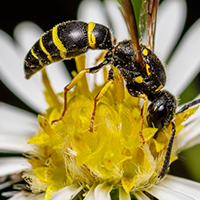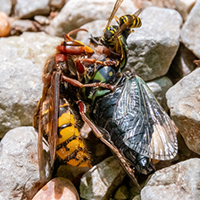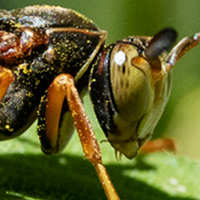
The 39th Insect Fear Film Festival will feature venomous insects and arthropods. The festival is entirely online this year, and entomology students will handle the stinging insects in the virtual petting zoo, with one student volunteering to get stung and explain his reaction in real time.
Courtesy Entomology Graduate Student Association
CHAMPAIGN, Ill. — One of the things people fear about insects is their sting.
The theme of this year's Insect Fear Film Festival is "Venom," and the festival will feature venomous insects and other arthropods such as spiders and centipedes. The 39th festival is Feb. 26 at 5 p.m., and like last year, it will be entirely online. The festival is free but advanced registration is required.
The theme seemed timely with so much news about the COVID-19 vaccine, said May Berenbaum, the founder of the film festival and the head of the entomology department at the University of Illinois Urbana-Champaign.
"There's been a lot of talk about being jabbed. With 10 billion vaccine doses delivered worldwide, that's a lot of jabbing. People might not know that the hypodermic syringe was inspired by a stinging insect," she said.
The insects also look good on camera.
"Stinging insects are often characterized by bright warning colors – yellow and black stripes, or black and red. They are advertising the fact that they are dangerous," Berenbaum said.

A potter wasp, also called a mason wasp. This type of wasp can sting people, but it is exceedingly uncommon.
Photo by Edward M. Hsieh
The theme was a good choice for an online festival. The insect petting zoo features the starring insects each year, and at a typical in-person setting the organizers couldn't allow guests to handle stinging insects.
Special guest Justin Schmidt will describe just how painful a sting can be from those insects. Schmidt is an entomologist with the Southwest Biological Institute in Tucson, Arizona, who developed the Schmidt sting pain index by allowing himself to be stung by a huge number of species of insects and recording evocative descriptions of the stings on a four-level pain scale.
Level one includes the sweat bee, whose sting is "light, ephemeral, almost fruity. A tiny spark has singed a single hair on your arm," and the red fire ant, with a sting that is "sharp, sudden, mildly alarming. Like walking across a shag carpet and reaching for the light switch."
The Western yellow jacket's sting is a level two: "Hot and smoky, almost irreverent. Imagine W.C. Fields extinguishing a cigar on your tongue."
The bullet ant of level four is said to be the most painful insect sting there is. Schmidt describes it as "pure, intense, brilliant pain. Like walking over flaming charcoal with a 3-inch nail embedded in your heel."
Insects use stings for different reasons. Some are a defense mechanism. For example, the honey bee – a social, vegetarian insect – stings only to educate a predator, not to kill it, Berenbaum said. Bees usually sting only to protect their nest, she said.

A European hornet (the larger insect on the left) and a yellow jacket (the smaller insect perched on the head capsule) feeding on a decapitated cicada.
Photo by Edward M. Hsieh
Predacious insects use their stings to paralyze or immobilize their prey. Even ticks can produce anticoagulants to prevent blood coagulation or neurotoxins to paralyze their hosts so they can continue to feed without interruption, Berenbaum said.
The stinger of bees, wasps and ants is a modified egg-laying device, so only the females of the species sting. In a hive, only the queen lays eggs; the female worker bees are sterile and use the structure to defend against enemies, she said.
Scorpions have stingers at the ends of their abdomens that are not egg-laying devices. Spiders deliver venom through fangs, and some arachnids don't have stingers at all – they spit venom from their mouths. Caterpillars also don't have stingers. Rather, they have stinging hairs that break off when something brushes against them, leaving a sharp point, or spines that are connected to venom glands that embed in the skin of potential enemies that come in close contact with them, Berenbaum said.
The venoms secreted through the stings "are all cocktails of physiologically active compounds. Some induce pain, some kill cells and cause tissue death, and some are spreading agents, allowing venom to spread over a surface. Venoms can damage or destroy muscle tissues, cause cardiac arrhythmias and impair the functioning of the nervous system," Berenbaum said.

A paper wasp.
Photo by Edward M. Hsieh
The film program will feature animated and live short films and clips from feature-length films, grouped according to three themes. The first group of film clips will show stings used for exaggerated comic effect, often with individual insects wielding their stingers like swords or with swarms of stinging insects taking on the shape of buzz saws.
The second group of films will show reactions to stings that are dramatic or horrific, including anaphylaxis, with characters swelling up to enormous proportions after being stung. The clips will include the most famous spider bite of all, showing how Peter Parker became Spider-Man.
The last group will feature videos of the reality of venomous insects, with high-speed videos demonstrating how stingers inject venom, educational videos showing how to use an Epi-Pen to stop allergic responses to stings, and a series of videos illustrating medical uses of venom and stings, including apitherapy, or the use of bee products including venom to treat various diseases or injuries.
Also at the festival:
Tommy McElrath, the insect collection curator for the Illinois Natural History Survey, will give a tour of the survey's insect collection focusing on venomous species.
Entomology students will present the virtual petting zoo with venomous insects and spiders. One graduate student has volunteered to be stung live on Zoom and explain his reaction in real time.
Ventriloquist Hannah Leskosky – Berenbaum's daughter – and her talking bee, Buzz, will discuss stings and venoms from the male bee perspective.
Bugscope, a scanning electron microscope at the Beckman Institute for Advanced Science and Technology, will show magnified venomous insects being imaged in real time.
The winners of the annual art contest will be announced, and images of the art will be shown online. The festival also will include a live session on stinging insect-themed crafts.






